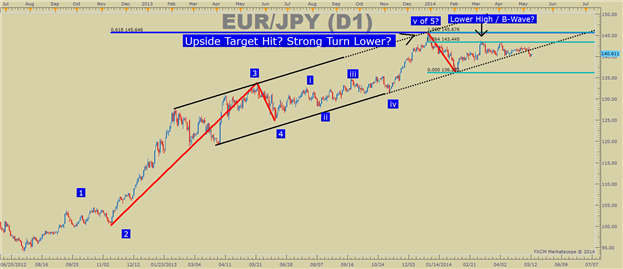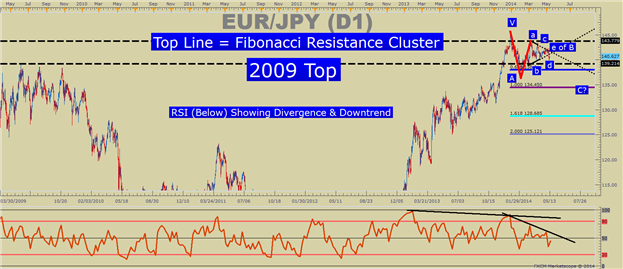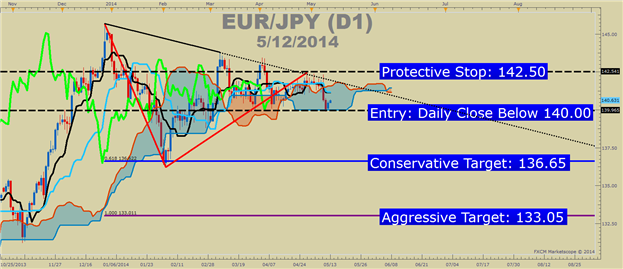From late 2012 to the 1st trading day of 2014, many traders felt the downtrend in the JPY
which pushes higher JPY crosses couldn’t be stopped. A lot of the
downfall in the JPY has been on the back of a major monetary policy
committee. For a while, the monetary policy taken on by the Bank of
Japan seemed to have all but sealed the victory of their war
on inflation all the while weakening the JPY. However, 2014 hasn’t been
kind to those looking for a weaker JPY and given the impending
EURJPY - An Impressive Trend
When you step back, you realize the EURJPY was the
perfect long trend trade based on each country’s monetary policy
standings in mid-2012. In late July, Mario Draghi of the European
Central Bank stated that they would do, “whatever it takes”, which
marked the low in many EURO crosses. At the same time, Shinzo Abe was
running for Prime Minister in Japan, and he was promising a restoration
of economic pride by raising inflation which would weaken the JPY and it
did. This made EURJPY a screamer to the upside since summer 2012, but
2014 has brought of shifting of tides that could allow us to find a
trading opportunity to the downside.
Learn Forex: EURJPY Has Finally Found Resistance

Presented by FXCM’s Marketscope Charts
The bottom left of the chart has the low put in
before Draghi’s comment mentioned earlier. As Euro strength began to
gather steam, so did JPY weakness. The JPY weakness ran throughout the
currency world but was most cleanly seen in EURJPY, which rose 5,100+
pips from mid-2012 to the beginning of 2014. After this strong push
higher, we’re going to look for a reversal or trend trading correction
as per Ichimoku rules to help us enter a higher probability trade.
Long Term Resistance
If we’re looking for a trade against the trend from
mid-2012, the first thing we want to see is levels and tools like
oscillators that show us that EURJPY is running out of steam. We have
both in looking at the Relative Strength Index & the 2009 intraday
high of 139.214 which are tipping us off to the potential for a strong
turn to the downside. Additionally, Elliott Wave also shows common
patterns that play out before another counter leg-move. If you’re
unfamiliar with Elliott Wave, here’s a quick breakdown of the tenets.
Learn Forex: 2009 High Could Soon Break As Support

Presented by FXCM’s Marketscope Charts
Looking above, you’ll notice that the 2009 Top is
under pressure and a handful of Fibonacci Resistance levels clustered
around the 144 level which as acted as resistance for a majority of
2014. The RSI tool shows us a clear divergence from the May peak to the December ’13 peak so that we can look for moves lower. Lastly, before we get to Ichimoku for triggers, you can see from the top chart that
a trendline dating back to February 2013 and the October ’13 low broke
last week, which further shows us weakening of the uptrend. Now, let’s
look at Ichimoku.
Ichimoku Set-Up with Key Levels
Last week, the European Central Bank said that they
were comfortable with the idea of cutting rates in June in order to ease
the pressure of low inflation on the economy. This week, ECB member,
Vitor Constancio said that he estimated the high levels on the EUR
have likely been the reason for 0.5% drop in inflation in recent
months. As the ECB began to express distaste for a higher Euro, many
traders began to sell aggressively and that brings about an opportunity
on EURJPY.
Learn Forex: A Lagging Line Bearish Break Would Trigger a EURJPY Short

Presented by FXCM’s Marketscope Charts
Ichimoku Trade: Sell EURJPY on a Close & Lagging Line below Daily Cloud @ 140.00
Stop: 142.50 (Above Exhaustion Point of Triangle and 2014 Trendline)
1st Limit: 136.65 (Just above 2014 Low & 61.8% Expansion of A Wave from End of Triangle)
2nd Limit: 133.05 (Equal Wave Target whereas C=A)
If this is your first reading of the Ichimoku report, here is a recap of the traditional rules for a sell trade:
-Price is below the Kumo Cloud
-The trigger line (black) is below the base line (light blue) or is crossing below
-Lagging line is below price action from 26 periods ago (we also received confirmation on cloud bounce)
-Kumo ahead of price is bearish and falling
-Entry price is not more
than 300 pips away from base line as it will likely whip back to the
line if we enter on an extended move.
No comments:
Post a Comment